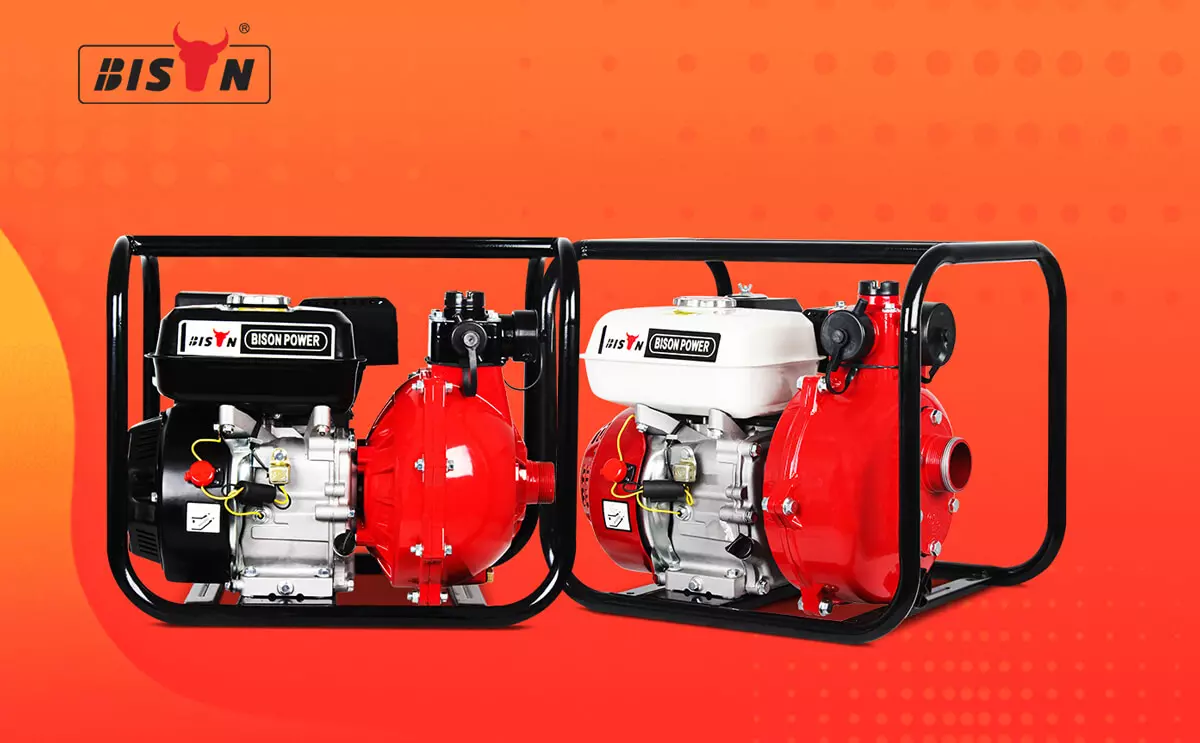Water pumps vs. trash pumps
2023-07-28
Table of content
As a leading water pump factory in China, we understand that your success depends not only on selling products, but also on providing valuable information to customers. This guide is designed to help you gain insight into water pumps and trash pumps - two important categories in your product range.
While they may look similar to the untrained eye, water pumps and trash pumps serve very different purposes and are used in different scenarios. From domestic use to commercial applications, from construction sites to flood management, knowing the difference between these two types of pumps can help you better advise customers and increase your sales.
Be prepared for BISON to delve into the specifics of these pumps, their unique features, benefits and how to help your customers choose the right pump for their needs. Let's advance your expertise together!

Water pumps
Water pump describes various types of pumps, which are divided into different classifications according to their application or function. The primary condition of a water pump is that it can deliver clean water without solid matter. The pump sends large volumes of fluid through small openings to high-pressure levels so any solid object larger than 0.25 inches cannot pass through. Some situations that require the use of water pump include:
Drain or fill pools, hot tubs, quarries, or ponds.
Water the lawn.
Remove water from the basement.
Perform municipal water maintenance.
Trash pumps
While standard water pumps are best suited for clean water applications, trash pumps can handle muddy water containing solids. These pumps can handle very large volumes of water but at lower pressure levels.
By operating at lower pressure, the trash pump can deliver water containing debris such as leaves, twigs, dirt clumps, and other matter between 0.75 and 1.25 inches. These materials will easily pass through the pump without damaging or clogging its components. Trash pumps can also deliver large volumes of water over large areas rather than centralized points.
Use trash pumps in industrial or agricultural applications such as:
Dewatering on construction sites or gravel pits.
Humidify the construction site to control dust.
Creek diversion.
Wastewater treatment.
Watering the fields.
Decide which pump model is right for you
There are a few things to consider when choosing or selecting between a water pump and a trash pump. In summary, the following factors should be kept in mind when selecting a pump configuration. By understanding these factors, you can make an informed decision and select the best pump for your project.
Likelihood of debris
Analyze the water you need to move to determine whether it contains hard debris. A pump will work fine if you’re drawing from a clean water source, but bodies comprising leaves, pebbles, twigs, and other debris require a trash pump.
Water volume and time constraints
Consider how much water you need to move and how much time it will take. Although the trash pump has a higher flow rate, the water pump will deliver water at a higher pressure and a faster pace.
Desired pressure
Some jobs require a lot of pressure, while others require more subtle pressure. The high-pressure capability of a water pump is excellent for sending water over long distances. In contrast, the lower pressure of a sump pump can distribute water over a surface without causing damage or displacing it.
Maintenance Issues
Both types of pumps need regular maintenance to ensure optimal performance and longevity. Water pumps are generally more economical and easier to maintain but are limited in their application due to their inability to handle solids. Trash pumps, while more costly, can handle a variety of materials, making them versatile for different projects.
How to choose the best water pump?
Just like purchasing any other product, you have to consider a few factors to purchase the right product. Here are 4 factors to consider when shopping for the best water pump:
Flow rate
This is usually the efficiency of the pump. Flow rate is the time it takes a pump to pump a specific volume of water, usually measured in liters per minute. If you plan to use your pump on a construction site or a farm, you should purchase a pump that pumps more than 2500 liters per minute. On the other hand, pumps with a flow rate between 100 - 200 liters per minute are suitable for any domestic use.
Inlet size
Most pumps have an inlet size between 1 and 6 inches, although in some cases, it may be larger. The larger the inlet valve size, the more water the pump will easily be able to pump, and the faster it will get the job done.
Maximum head and pressure
The maximum head of a pump is the longest distance the pump can pump water. For example, if you purchase a pump with a maximum head of 60 meters, the flow will be zero if you try to pump water above that.
Pump quality
It would help if you first considered the brand of the water pump. The engine or motor can also tell you the quality of the pump. Conduct the necessary research and investigation on the quality of the pump and make sure to purchase a water pump manufactured by a reputable brand like BISON.
How to choose the best trash pump?
While general water pumps and trash water pumps share many common factors to consider during purchase, it's important to note that trash water pumps have additional unique requirements. In this section, we will delve deeper into these specialized considerations to ensure your trash water pump is well-suited for its task.
Size of solids
This capacity refers to the size of solids the pump can handle without clogging. It's typically measured in inches. Know the material you are pumping. If you likely encounter 2” solids, do not choose a pump designed for 1” solids. Eventually, a clog will develop and may even cause damage to the pump.
If you're dealing with larger debris or a higher volume of solids, you might need a semi-trash pump or a full trash pump.
Volume of liquid being moved
Knowing the volume required is critical to sizing the pump. Trash pumps range from 3-inch pumps with a flow rate of 200 gallons per minute (gpm) to 18-inch pumps with a flow rate of 10,000 gpm to 11,000 gpm. Remember, volume is limited by hose size.
Your preferred power supply
Smaller trash pumps are electric or gas-powered. Larger trash pumps have traditionally been diesel-powered, but due to cost and sustainability concerns, more and more electric models are available today.
Material Quality
Trash pumps often deal with abrasive materials, so they need to be built from durable, corrosion-resistant materials like cast iron or stainless steel. BISON trash pumps on the market are made of cast iron for its resistance to wear and tear.
FAQs
What is the main difference between a “trash pump” and a “high-pressure pump”?
A significant difference exists between using a trash pump and a high-pressure pump when supplying water to large sprinklers. Trash pumps are designed for high flow and low pressure. High-pressure pumps are designed to deliver water at higher pressures.
For example, a 2-inch trash pump pumps 50 gpm at 35 psi. At the same time, the 2-inch high-pressure pump pumps 50 gpm at 65 psi. For your large sprinklers to perform at their best, flow needs to be delivered to the sprinklers at high pressure.
What size solids can a trash pump handle?
The size of solids that a trash pump can handle depends on the size and model of the pump. The main determining factors are the diameters of the suction and discharge ports and the clearance between the volute and the impeller.
A 2-inch trash pump handles solids up to 1 inch. A 3” trash pump can handle solids up to 1.5”.
How far can the trash pump efficiently pump water?
A typical centrifugal trash pump can lift suction to 25 feet, depending on the application. A trailer-mounted trash pump can lift liquids to 150 feet.
Can a trash pump be used for sewage?
Adequately sized trash pumps are usually suitable for removing sewage sludge. However, it may clog if the solids concentration is too high (more than 3% or 5%, depending on the pump). It would help to have a sludge pump for larger solids or higher solids concentrations.
Get the best water and trash pumps from BISON
The BISON, an industry-leading manufacturer, offers various water and trash pumps at wholesale rates.
For help selecting the right pump for your situation, call X. If you still need help understanding the differences and similarities between water and trash pumps, please get in touch with us. Our experts are always ready to answer your questions and help you select the best pump for your needs.

